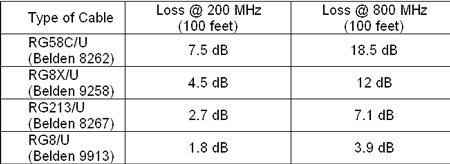

pro-av-articles_more-from-wireless-mics
Antenna cable loss, scanners and frequency finders, and a little science.
The nature of radio frequency propagation in cables is such that significant losses can occur in relatively short lengths of cable. The loss depends on the type of cable and the frequency of the signal. The table below gives approximate losses for some commonly used antenna cables. In general, antenna cables should be kept as short as possible, and the number of connections in the signal path should be kept to a minimum. Any loss greater than about 5 dB should be compensated for by the use of an antenna amplifier located at the antenna-end of the cable.
Antenna Cable Loss
Scanners and Frequency Finders
Some wireless microphone manufacturers offer online tools to make the task of finding frequencies in a particular location easier. Here are a few.
Audio-Technica
Lectrosonics
Sennheiser
Shure
To find out exactly what kind of RF signals are in the air when you’re on location, a standalone radio frequency scanner that connects to your PC can be helpful. One that is well suited to wireless microphone users is the WinRadio model WR-G305e/WFM or WR-G305e/WFM-PD (visit www.winradio.com for more information).
A Little Science
Radio waves are periodic variations in electromagnetic energy, which travel through air or through a vacuum. Radio signals are radio waves whose frequency, amplitude, or phase has been varied or “modulated” in a controlled fashion so as to carry information, such as sound, images, or data.
Radio waves travel at the speed of light (186,000 miles per second; 300 million meters per second). The frequency and wavelength are related, making the wavelength easy to calculate if the frequency is known. The length of a radio wave is 300 divided by the frequency in megahertz. A 200 MHz radio wave is 1.5 meters long (about 5 feet), while a 700 MHz wave is only .43 meters long (about 17 inches). The wavelength determines how a radio wave will behave when it encounters a metal object or surface. If the wavelength is significantly larger than a metal object, the wave will pass by and around the object as if it wasn’t there. If the wavelength is smaller than an opening in a metal surface, the wave will pass through the opening; otherwise it will be reflected as if the surface were solid. The length of the transmitting and receiving antennas is also determined by the wavelength.
Radio transmitters and receivers interact or “intermodulate” with each other to create additional signals called “intermodulation products.” The intermodulation products can interfere with other wireless microphone signals, and so they must be carefully considered whenever three or more wireless microphones are used.
Wireless microphones, in-ear monitors, intercoms, etc. all operate in the same part of the spectrum: the TV band. This part of the spectrum is primarily used by broadcast TV stations. Wireless audio devices are allowed to use this spectrum as long as they avoid active TV channels.










